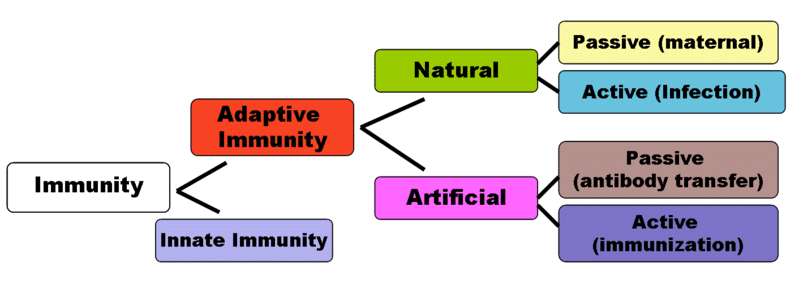The body relies on the adaptive immune system and immunological memory to provide immunity and prevent recurrent infections with the same illness. This can also be taken advantage of within medicine through things such as vaccinations.
The various ways in which immunity is developed are generally split into ‘active’ (i.e. due to the body’s own immune response and immune cells) and ‘passive’ (i.e. as a result of antibodies) immunity. This article will consider the different types of immunity and finally, their roles within the immune system.
Active Immunity
Active immunity is when the body’s own immune system mounts an adaptive immune response following direct exposure to a disease organism or antigen. It can develop either naturally or artificially.
Active immunity, in contrast to passive immunity, takes time to develop but is long-lasting as it produces memory lymphocytes that recognise the disease and promptly produce the antibodies needed to fight it.
Natural
Generally speaking, natural active immunity happens after infection with the actual disease. Exposure to the pathogen and the subsequent immune response produce memory cells that can recognise and rapidly respond to the pathogenic agent on re-exposure.
Artificial
Vaccination can artificially stimulate active immunity. In brief, this is where the body is exposed to a dead or weakened form of the pathogen, which, though unable to mount an infection, still activates the adaptive immune response and memory cell formation.
The main advantage of vaccination is that it avoids the need for an active infection to confer immunity which can be fatal in some diseases. However, some pathogens change their antigen structure over time (particularly viruses), enabling them to evade immunological memory. This might necessitate re-vaccination such as the case with the influenza virus vaccine.
Passive Immunity
Passive immunity relies on antibodies rather than memory cells. In brief, It involves the introduction of ready-made antibodies to a non-immune individual.
Passive immunity is short-lived (because there are no memory cells) but beneficial where there is a high risk of infection, and the body is unable to develop its own immune response or synthesize its’ own antibodies. It can also alleviate the symptoms of some diseases and treat certain infections that have no available vaccine (e.g. Ebola virus).
Furthermore, they can be used prophylactically in immunodeficient patients and where there is insufficient time for the body to develop its own immune response. for example, antivenom serum for poisoning.
Natural
Passive immunity can be passed down in the form of IgG from mother to foetus. IgG is the only antibody subtype that can cross the placenta and subsequently provides protection for 4 to 6 months after birth.
After that, maternal antibodies are gradually degraded as the infant’s immune system continues to develop until it reaches maturity at around 5 years of age.
IgA antibodies present in breast milk can also transfer passive immunity. IgA coats the gastrointestinal tract of the infant, protecting against bacterial infections until the newborn’s immune system is mature enough to produce its own antibodies. This immunity is short-lived, and vaccination is required shortly after birth to prevent diseases such as tuberculosis and hepatitis B.
Artificial
IgG antibody transfer can provide artificial passive immunity.
These can be through several ways:
- Human or animal blood products – serum or plasma
- Pooled human immunoglobulin – intravenous, subcutaneous or intramuscular immunoglobulin from immunised donors or those recovering from the disease.
- Monoclonal antibodies
The protection conferred is immediate but temporary. Furthermore, as the body does not develop memory cells, the patient is at risk of disease relapse or re-infection unless they develop active immunity.
Active vs. Passive Immunity – Summary
|
Active Immunity |
Passive Immunity |
| An Individual’s own immune system produces the antibodies needed. | Involves the introduction of external antibodies |
| Direct contact with antigen stimulates antibody production | The pathogen does not need to have direct contact with the body. |
| Response takes time to develop and there is a lag phase | Rapid response |
| Long-lasting | Transient |
| Generates immunological memory | No memory response |
| It does not work with immunodeficient patients | Works in immunodeficient patients |
| Few adverse events | Risk of hypersensitivity reactions and serum sickness (especially with non-animal sources) |
Clinical Relevance – Immunoglobulin Therapy
Immunoglobulin therapy is an immunomodulatory treatment. After pooling the plasma of 1000-30,000 blood donors and then purifying the product of all other components aside from IgG, this blood-based therapy has various uses across autoimmune, infectious and idiopathic diseases.
Immunodeficient patients (e.g., patients with common variable immunodeficiency) may lack the ability to make functional antibodies or to make antibodies in sufficient quantities to fight off disease, resulting in more frequent and severe infections. In these situations, immunoglobulin replacement therapy confers passive immunity by increasing the number of functional antibodies.
Immunoglobulin therapy can alleviate the severity of some autoimmune diseases like Guillain-Barré syndrome. In essence, IV immunoglobulin still has its Fc component which blocks the Fc receptor on macrophages. Consequently, this prevents them from phagocytosing antigen-presenting cells and mediating antibody-dependent cellular cytotoxicity. This ultimately inhibits macrophage-mediated demyelination and reduces symptoms.

